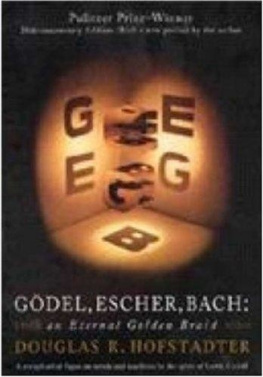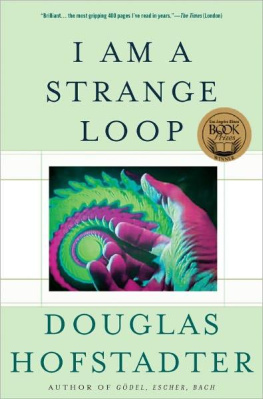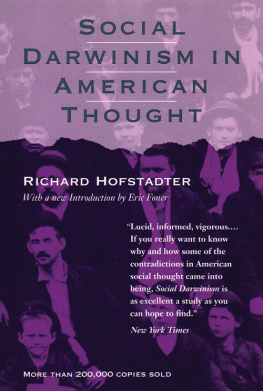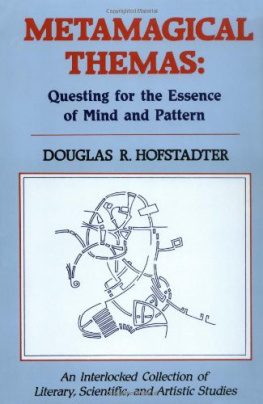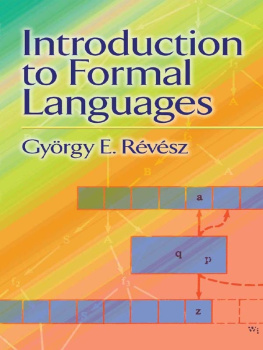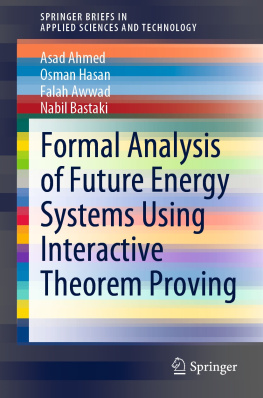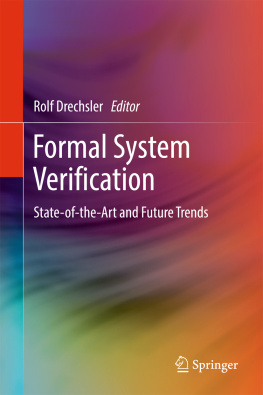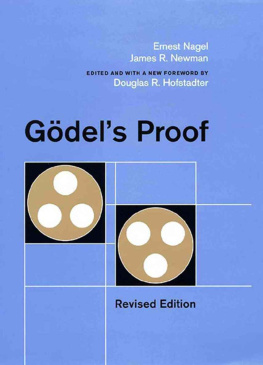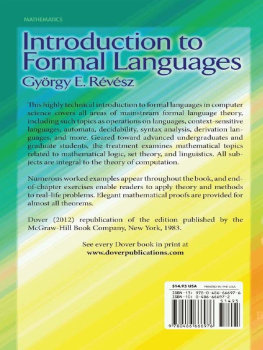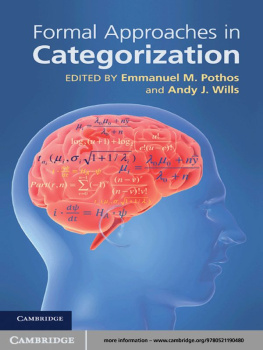
Contents
Overview
viii
List
of
Illustrations
xiv
Words
of
Thanks
xix
Part I: GEB
Introduction: A Musico-Logical Offering
Three-Part
Invention
Chapter
I:
The
MU-puzzle
Two-Part
Invention
Chapter II: Meaning and Form in Mathematics
Sonata for Unaccompanied Achilles
Chapter III: Figure and Ground
Contracrostipunctus
Chapter IV: Consistency, Completeness, and Geometry
Little
Harmonic
Labyrinth
Chapter V: Recursive Structures and Processes
Canon by Intervallic Augmentation
Chapter VI: The Location of Meaning
Chromatic Fantasy, And Feud
Chapter VII: The Propositional Calculus
Crab
Canon
Chapter VIII: Typographical Number Theory
A
Mu
Offering 231
Chapter IX: Mumon and Gdel
Contents
II
Part II EGB
Prelude
...
Chapter X: Levels of Description, and Computer Systems
Ant
Fugue
Chapter
XI:
Brains
and
Thoughts
English
French
German
Suit
Chapter
XII:
Minds
and
Thoughts
Aria
with
Diverse
Variations
Chapter XIII: BlooP and FlooP and GlooP
Air
on
G's
String
Chapter XIV: On Formally Undecidable Propositions of TNT
and Related Systems
Birthday
Cantatatata
... 461
Chapter XV: Jumping out of the System
Edifying Thoughts of a Tobacco Smoker
Chapter
XVI:
Self-Ref
and
Self-Rep
The
Magn
fierab,
Indeed
Chapter XVII: Church, Turing, Tarski, and Others
SHRDLU, Toy of Man's Designing
Chapter XVIII: Artificial Intelligence: Retrospects
Contrafactus
Chapter XIX: Artificial Intelligence: Prospects
Sloth
Canon
Chapter XX: Strange Loops, Or Tangled Hierarchies
Six-Part
Ricercar
Notes
Bibliography
Credits
Index
Contents
III
Overview
Part I: GEB
Introduction: A Musico-Logical Offering . The book opens with the story of Bach's Musical Offering. Bach made an impromptu visit to King Frederick the Great of Prussia, and was requested to improvise upon a theme presented by the King. His improvisations formed the basis of that great work. The Musical Offering and its story form a theme upon which I "improvise"
throughout the book, thus making a sort of "Metamusical Offering". Self-reference and the interplay between different levels in Bach are discussed: this leads to a discussion of parallel ideas in Escher's drawings and then Gdels Theorem. A brief presentation of the history of logic and paradoxes is given as background for Gdels Theorem. This leads to mechanical reasoning and computers, and the debate about whether Artificial Intelligence is possible. I close with an explanation of the origins of the book-particularly the why and wherefore of the Dialogues.
Three-Part Invention. Bach wrote fifteen three-part inventions. In this three-part Dialogue, the Tortoise and Achilles-the main fictional protagonists in the Dialogues-are "invented" by Zeno (as in fact they were, to illustrate Zeno's paradoxes of motion). Very short, it simply gives the flavor of the Dialogues to come.
Chapter I: The MU-puzzle. A simple formal system (the MIL'-system) is presented, and the reader is urged to work out a puzzle to gain familiarity with formal systems in general. A number of fundamental notions are introduced: string, theorem, axiom, rule of inference, derivation, formal system, decision procedure, working inside/outside the system.
Two-Part Invention. Bach also wrote fifteen two-part inventions. This two-part Dialogue was written not by me, but by Lewis Carroll in 1895. Carroll borrowed Achilles and the Tortoise from Zeno, and I in turn borrowed them from Carroll. The topic is the relation between reasoning, reasoning about reasoning, reasoning about reasoning about reasoning, and so on. It parallels, in a way, Zeno's paradoxes about the impossibility of motion, seeming to show, by using infinite regress, that reasoning is impossible. It is a beautiful paradox, and is referred to several times later in the book.
Chapter II: Meaning and Form in Mathematics. A new formal system (the pq-system) is presented, even simpler than the MIU-system of Chapter I. Apparently meaningless at first, its symbols are suddenly revealed to possess meaning by virtue of the form of the theorems they appear in. This revelation is the first important insight into meaning: its deep connection to isomorphism. Various issues related to meaning are then discussed, such as truth, proof, symbol manipulation, and the elusive concept, "form".
Sonata for Unaccompanied Achilles . A Dialogue which imitates the Bach Sonatas for unaccompanied violin. In particular, Achilles is the only speaker, since it is a transcript of one end of a telephone call, at the far end of which is the Tortoise. Their conversation concerns the concepts of "figure" and "ground" in various
Overview
IV
contexts- e.g., Escher's art. The Dialogue itself forms an example of the distinction, since Achilles' lines form a "figure", and the Tortoise's lines-implicit in Achilles' lines-form a "ground".
Chapter III: Figure and Ground . The distinction between figure and ground in art is compared to the distinction between theorems and nontheorems in formal systems. The question "Does a figure necessarily contain the same information as its ground%" leads to the distinction between recursively enumerable sets and recursive sets.
Contracrostipunctus . This Dialogue is central to the book, for it contains a set of paraphrases of Gdels self-referential construction and of his Incompleteness Theorem. One of the paraphrases of the Theorem says, "For each record player there is a record which it cannot play." The Dialogue's title is a cross between the word "acrostic" and the word "contrapunctus", a Latin word which Bach used to denote the many fugues and canons making up his Art of the Fugue . Some explicit references to the Art of the Fugue are made. The Dialogue itself conceals some acrostic tricks.
Chapter IV: Consistency, Completeness, and Geometry . The preceding Dialogue is explicated to the extent it is possible at this stage. This leads back to the question of how and when symbols in a formal system acquire meaning. The history of Euclidean and non-Euclidean geometry is given, as an illustration of the elusive notion of "undefined terms". This leads to ideas about the consistency of different and possibly "rival" geometries. Through this discussion the notion of undefined terms is clarified, and the relation of undefined terms to perception and thought processes is considered.
Little Harmonic Labyrinth . This is based on the Bach organ piece by the same name. It is a playful introduction to the notion of recursive-i.e., nested structures. It contains stories within stories. The frame story, instead of finishing as expected, is left open, so the reader is left dangling without resolution. One nested story concerns modulation in music-particularly an organ piece which ends in the wrong key, leaving the listener dangling without resolution.
Chapter V: Recursive Structures and Processes . The idea of recursion is presented in many different contexts: musical patterns, linguistic patterns, geometric structures, mathematical functions, physical theories, computer programs, and others.
Canon by Intervallic Augmentation . Achilles and the Tortoise try to resolve the question, "Which contains more information-a record, or the phonograph which plays it This odd question arises when the Tortoise describes a single record which, when played on a set of different phonographs, produces two quite different melodies: B-A-C-H and C-A-G-E. It turns out, however, that these melodies are "the same", in a peculiar sense.
Next page
